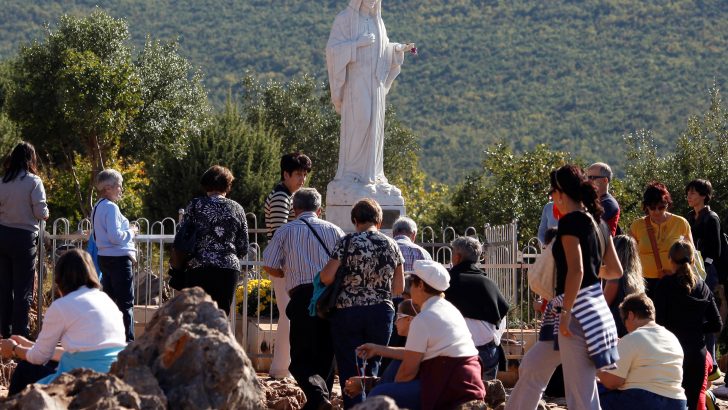Church officials have adopted a warmer attitude towards the reported apparitions, writes Michael Kelly
For devotees of Medjugorje, shifting attitudes in the Church on the phenomenon only confirm what they already believe: that the small town in Herzegovina is a place where heaven meets earth and wonderous things happen through the intercession of the Mother of God. An estimated 30,000 Irish people – many of them young people – visit the Marian town every year.
Many others – also devout Catholics – remain immensely sceptical and whilst Pope Francis has ushered in a thawing in the official Church’s position on Medjugorje, there is still no ecclesiastical approval for the reported apparitions.
Ever since 1981, when six local children reported that they had seen the Blessed Virgin Mary, Irish people have been amongst the first visitors to the town. Devotion to the Mother of God as Our Lady of Medjugorje has been popular in Ireland and it has inspired numerous prayer groups around the country.
Vocation
Anecdotally, many of those going forward for priesthood and religious life also attribute the flowering of their vocation to Medjugorje. The success of the Community Cenacolo in Medjugorje helping people suffering from crippling addictions has also led many people to associate the town with healing and helping people in desperate circumstances to get their lives back.
The story begins on June 24, 1981 when Mirjana Dragicevic and Ivanka Ivankovic reported seeing an apparition of the Virgin Mary. The following day, another vision was reported by Mirjana and Ivanka and this time four other young people reported seeing it as well: Marija Pavlovic, Jakov Colo, Vicka Ivankovic, and Ivan Dragicevic.
The teenagers claim that they saw an apparition on Podbrdo Hill; the alleged apparition was a young woman with an infant in her arms. Surprised and scared, they did not approach. The next day at the same time four of the youths returned, and were later joined by the other two.
At the time of the first alleged apparition Vicka was 16 years old. She claims to have prayed and talked with Our Lady and to have been given nine ‘secrets’. Her ‘prayer mission’, given by the Blessed Virgin Mary, is to pray for the sick.
One of the challenges facing the Church is that the phenomenon is still ongoing. Three of the alleged seers – Ivan, Marija and Vicka – claim that Our Lady still appears to them on a daily basis. The other three, Mirjana, Ivanka, and Jakov, say they no longer see Our Lady daily.
The ongoing nature of Medjugorje makes it difficult for Church authorities to make a definitive judgement on whether or not what is occurring is supernatural and, therefore, worthy of belief. Yet, the four basic messages of prayer, peace, fasting and penance are entirely consistent with the Catholic Faith.
Medjugorje is an international reference point for prayer where extraordinary spiritual fruits can be touched by hand”
Pope Francis has taken a pragmatic approach to Medjugorje. In 2017, he said that he believed that the original apparitions more than three decades ago deserve further study, but has also voiced doubt in the supposed ongoing visions.
He also stressed the need to distinguish between the two sets of apparitions, referencing a report submitted to the Vatican’s Congregation for the Doctrine of the Faith by a commission set up to study the apparitions by Benedict XVI in 2010.
“The first apparitions, which were to children, the report more or less says that these need to continue being studied,” he said, but as for “presumed current apparitions, the report has its doubts.”
“I personally am more suspicious – I prefer the Madonna as Mother, our Mother, and not a woman who’s the head of an office, who every day sends a message at a certain hour. This is not the Mother of Jesus. And these presumed apparitions don’t have a lot of value.”
He clarified that this is his “personal opinion” but added that Our Lady does not function by saying: “Come tomorrow at this time, and I will give a message to those people.”
However, Francis also pointed to the fact that the “real core” of the commission’s report, is “the spiritual fact, the pastoral fact” that thousands of pilgrims go to Medjugorje and are converted. “For this there is no magic wand; this spiritual-pastoral fact cannot be denied.”
The spiritual fruits of the pilgrimages, he said, are the reason why he appointed Polish Archbishop Henryk Hoser of Warsaw-Praga to study the best ways to provide pastoral care to townspeople and the pilgrims.
Archbishop Hoser has said that “Medjugorje is an international reference point for prayer where extraordinary spiritual fruits can be touched by hand”.
Changes
One of the key changes has been that the Vatican has lifted a ban on bishops leading pilgrimages to the site. “People claim to feel the presence of Mary,” Archbishop Hoser said, “but allowing pilgrimages must not be interpreted as an authentication of the known events tied to the name Medjugorje.”
He continued to state that the site is “a place, blessed by God, of encounter and dialogue with the Lord through the Virgin.”
It will be an occasion to enrich Faith and draw closer to God”
Bishop of Waterford and Lismore Phonsie Cullinan was the first Irish bishop to lead a group to the shrine last August, and Bishop Fintan Monahan of Killaloe will lead a pilgrimage for readers of The Irish Catholic in July this year. The pilgrimage is an opportunity for people to ‘come and see’. Many pilgrims will already be familiar with Medjugorje, while many others will be either unfamiliar or even have their questions and doubts.
Together, it will be an occasion to enrich Faith and draw closer to God and witness the joy, sense of peace and experience of healing that is the story of Medjugorje for many people. I hope you will consider joining us on this special pilgrimage.
For more information please visit here


 Michael Kelly
Michael Kelly Pilgrims surround a statue of Mary on Apparition Hill in Medjugorje, Bosnia-Herzegovina
Photo: CNS
Pilgrims surround a statue of Mary on Apparition Hill in Medjugorje, Bosnia-Herzegovina
Photo: CNS 